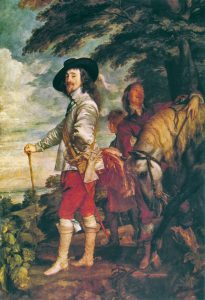Anthony van Dyck, Charles I at the Hunt
One of Rubens’ collaborators, Anthony van Dyck (1599-1641), had an illustrious independent career as a portraitist. He began his association with Rubens as a specialist in painting heads. The need to blend his work seamlessly with that of Rubens enhanced Van Dyck’s technical skill. After a trip to the English court of James I in 1620, Van Dyck traveled to Italy and worked as a portrait painter for seven years before returning to Antwerp. In 1632 he returned to England as the court painter to Charles I, by whom he was knighted and given a studio, a summer home, and a large salary.

Van Dyck’s many portraits of the royal family provide a sympathetic record of their features and demeanor. In Charles I at the Hunt of 1635, Van Dyck was able, by clever manipulation of the setting, to portray the king truthfully and still present him as an imposing figure. Dressed casually for the hunt and standing on a bluff overlooking a distant view (a device used by Rubens to enhance the stature of Henry IV), Charles, who was in fact very short, appears here taller than his pages and even than his horses, since its head is down and its heavy body is partly off the canvas. The viewer’s gaze is diverted from the king’s delicate and rather short frame to his pleasant features, framed by his jauntily cocked cavalier’s hat and the graceful cascade of his hair. As if in decorous homage, the tree branches bow gracefully toward him, echoing the circular lines of the hat.[1]
- Marilyn Stokstad, Art History, vol. 2, 4th ed, (Upper Saddle River, NJ: Prentice Hall: 2011), 741. ↵

